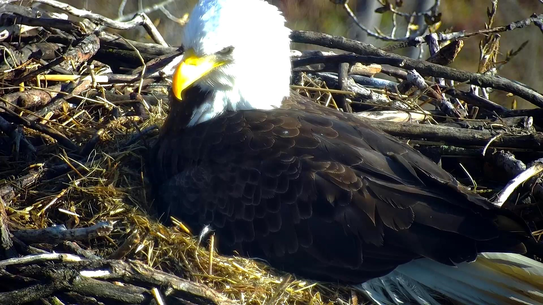|
March 26, 2021
 Mom listening to peeps?
 See pip on top of front egg
WARNING: Cute, fuzzy bobble-heads just ahead!
Yesterday, March 25, we were ale to confirm our first pip! While the cam was zoomed in on the eggs, we noticed a tiny beak with its egg tooth popping out of the pip hole. The egg tooth is a small nub on the top of the beak with which the chick scrapes the inside of the egg, until it creates a small hole in the shell. This means that hatch should occur within 24 hours. Since March 22 was 35 days from the first egg, this pip is likely the first egg to have been laid. The second egg was laid five days from the first and will hatch within a day or two, as well. This synchronized hatching is due to delayed incubation. The five days before the second egg was laid, the parents were only incubating enough to keep the egg from freezing. Full incubation (the "cooking" process) began as soon as the second egg was laid. This delayed incubation allows both eggs to hatch within a day or two of each other. This process gives the chicks the best chance at survival. When one chick is 5 days further developed than the first, the smaller chick does not fare well. Older, stronger siblings can beat up or kill a younger sibling (something we have sadly witnessed in the past). This is just the way nature works. As we have said before, having only two mouths to feed should be easier for the new pair to manage.
An interesting observance was made at another eaglecam this week. The nest also has a microphone, but it is right in the nest (ours is not). The eggs are very close to hatching, and when it was very quiet, the mic picked up the chicks peeping in the egg! Our nest is in an urban area with lots of noise around, and because our mic could not be placed right in the nest, we cannot hear chicks peeping. But we can be sure mom and dad hear it! The first picture above, shows the female looking like she might be listening to something. Could it be the peeping of her chicks? It's hard to tell, but it is is one way the eagles know their eggs are about to hatch.
Watching the cam in the next few weeks will be very exciting. Watching these huge, regal birds gently feeding their young tiny pieces of food is one of nature's finest displays. The first food brought to the nest is generally fish. We've not seen this pair eat fish yet this season, so the next few days should prove interesting and educational.
The new, young male has a lot of learning to do and the female will show him the ropes as she has been doing throughout this season. He has picked up this nesting and incubating thing very well and seemed like he knew just what to do at each stage. While it's common for the male to bring food to the female while she is incubating, this male has been relieving the female to allow her to catch her own food. When he isn't relieving her, he is fiercely defending the nest from intruders and would-be suitors. He has been busy! Our on-the-ground photographers have seen him chasing away bird after bird, keeping the female safe to incubate their eggs.
This pair should prove to be good parents to the new chicks and will will soon see dry fuzz-heads in the nest - likely this weekend. Enjoy the cam, but be sure to get outside and enjoy spring. Whether you're in Minnesota or California, it's a beautiful time of year.
State and federal officials have extended the deadline for filing individual income taxes from the usual April 15 to May 17 this year. That means more time to get outside and experience the exciting sights, sounds and smells of Spring! It also gives you an extra month to consider designating an amount to be donated to the Nongame Wildlife Program on line 18 of your Minnesota income tax form. The Nongame Wildlife Program helps protect Minnesota's wildlife diversity, and it provides opportunities to learn about our natural world through features such as this EagleCam.
|